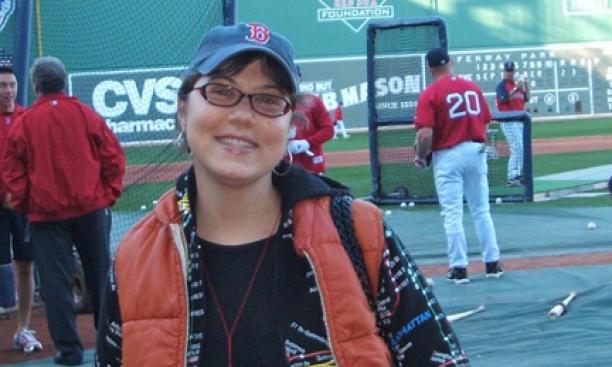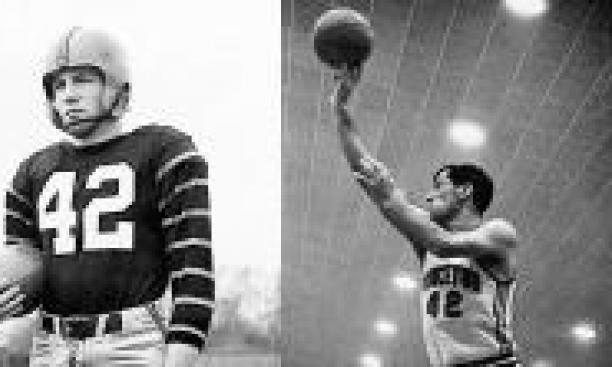
 Tiger of the Week: Ibby Caputo ’03
Tiger of the Week: Ibby Caputo ’03

The Oct. 8 Tiger of the Week has not been making news. Not yet. But Ibby Caputo ’03 is anxious to put her byline on stories and radio broadcasts soon. Caputo, who graduated from the Columbia University Graduate School of Journalism in 2007, spent the last year fighting acute myelogenous leukemia, which doctors feared would be fatal -- at her initial diagnosis, they gave her six weeks to live. A stem-cell transplant helped to put the disease into remission, and Caputo's strength is returning, according to her father, Steve Caputo ’75. On Oct. 4, Ibby Caputo talked about her experiences at the Leukemia and Lymphoma Society's Light the Night fundraiser in Franklin Township, N.J., where she was an "honored hero." "I accepted that I might live and I might die, but my choice was life," she said. "I chose life. I knew I that I only had two cents worth of say in the matter, and I wholeheartedly put those two cents in God's piggy bank." In recent weeks, Caputo has been pitching freelance stories, conducting interviews, and looking for a fulltime public-radio job in Boston. As she wrote to friends and family in August, a year to the day after her diagnosis, "I'm itching to move on."
Above, Ibby Caputo ’03 on the field at Fenway Park Sept. 25. The tickets were a gift from Red Sox president and CEO Larry Lucchino ’67, a lymphoma survivor. For more about Ibby's story, visit teamibby.com. (Photo courtesy Steve Caputo ’75)
Do you have a nominee for Tiger of the Week? Let us know. All alumni qualify. PAW's Tiger of the Week is selected by our staff, with help from readers like you.
 Senior thesis spotlight: On safari
Senior thesis spotlight: On safari
While many of his peers in the Class of 2009 studied for the LSAT or worked for investment banks or consulting firms this summer, Chip Snyders, an ecology and evolutionary biology major, went on safari. Snyders was a part of the research team led by Daniel Rubenstein, the Class of 1877 Professor of Zoology. In doing research for his senior thesis, Snyders spent two months in a part of Kenya known as the Laikipia Plateau, where he studied livestock and land usage on the ranches that comprise the region. On any given day, Snyders walked 5 to 10 km with the animals, studying their foraging behavior patterns and mapping changes in the vegetation in the areas that the herds frequented. Hi thesis work could provide information about the foraging patterns of the herds of goats, sheep, and camels that he studied, and also inform ranch managers of the most efficient use for their livestock grazing land. After a long day in the field, the research team returned to their camp - tents on the ranch where they ate, slept, and compiled data during their stay. In addition to having to struggle with no electricity except for two hours a day of computer battery life on which to record data, the group also had to manage the occasional wildlife invader. "There were times when nature definitely got too close," Snyders said, recalling a wild elephant that strolled into camp and almost charged at the researchers. "It was roughing it to the extreme." Snyders' most fulfilling experiences in Kenya came from meeting the local pastoralists - the Maasai people - and learning about their culture. "It was liberating and delightfully challenging to live in totally different circumstances for some time," he said. By Julia Osellame ’09 (Photo courtesy Chip Snyders ’09)
Tracking the state polls
The Oct. 5 New York Times front page featured a preview of this year's electoral college map, shaded to show five categories: states that favor McCain; states that favor Obama; states leaning toward McCain; states leaning toward Obama; and "tossup" states, the five states that may decide the November election. The Times designations relied on state polls of likely voters. But how reliable are those polls? In 2004, state polls predicted conducted late in the race were fairly accurate. But an Oct. 7 panel of political scientists and polling experts, speaking at Princeton's at Dodds Auditorium, said this year could be different. Larry Hugick, the chairman of Princeton Survey Research Associates International, said that state polls are generally less accurate than national ones, and the failure of many pollsters to reach voters who have a cell phone but no landline phone creates a "coverage problem" that causes inaccurate measures of younger voters. Joe Lenski ’87, executive vice president of Edison Media Research, said the traditional polling criteria for determining likely voters - questions like "Did you vote in the last election?" and "Are you registered to vote?" - are flawed because there are many active newly registered voters, and in some states, voters can register on election day. Christopher Achen, the Roger Williams Straus Professor of Social Sciences, said pollsters have trouble predicting turnout, and that has a significant influence on state-by-state outcomes. Lenski, an expert in exit polling, said voters may change their minds in the final days or hours of a campaign, so pre-election polls may have trouble keeping up. "I can't predict what the results will be," he said, "but I can predict that after the election, we're going to be doing a lot of study about whether we got it right or wrong."
Princeton teams to retire No. 42

By the time Bill Bradley ’65 arrived on campus, Dick Kazmaier ’52's No. 42, worn on his jersey during a legendary football career in which he won the 1951 Heisman Trophy, already held a fond place in the memories of Princeton fans. But when Bradley stepped on the Dillon Gym floor wearing the same digits, another star was born. Frank Deford ’61, then a rookie writer at Sports Illustrated, boldly predicted in the magazine that "the orange and black 42 is likely to be retired from the basketball court, too." No Princeton football or basketball player has worn No. 42 since Kazmaier and Bradley, but until this month, that was simply a matter of tradition. On Oct. 24, the University will officially retire the number for all sports and honor both Kazmaier and Bradley at a special ceremony in Jadwin Gym. Writer John McPhee ’53, a former roommate of Kazmaier and chronicler of Bradley's early career, will introduce the two honorees. For information and tickets, visit princetonvarsityclub.com. (Photos courtesy Office of Athletics Communications)
